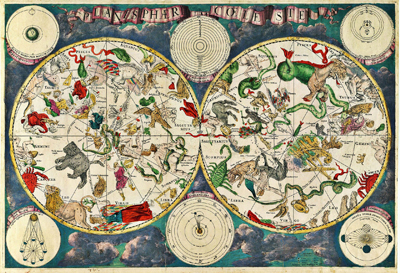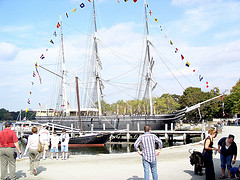National Endowment for the Humanities and STEM Funding Opportunities

Research suggests that integrating concepts from the humanities into science educational experiences can help to strengthen learning. Fortunately, many informal learning institutions have facilities, collections, exhibits, programs, and in-house staff expertise that can support science content and non-cognitive learning outcomes—like motivation, curiosity, and interest in science—through humanities-based experiences. At the 2014 Association of Science-Technology Centers conference in Raleigh, NC, Peter Fristedt of the National Endowment for the Humanities (NEH) and two representatives from NEH-funded projects in science centers talked about the new opportunities available from NEH for science-humanities projects. The session explored what it means for humanities and science, technology, engineering, and math (STEM) to be in dialogue with one another, and how that translates to actual work, such as exhibits.
What are the Humanities, and what does NEH do?
Fristedt began by giving several different definitions for the broad field known as "the humanities":
- A set of disciplines (including art, literature, philosophy, legal studies, cultural studies, etc.)
- A set of questions about our world (such as: Why did some particular historical event happen? How have different members of groups been represented in Western art? What counts as 'ethical' behavior?)
- A set of approaches (for example, archival research, oral histories, close reading) that increasingly includes the use of digital and empirical tools
He also outlined some ways in which the humanities intersect with science and technology.

How do the humanities intersect with science and technology?
Since 1965, the National Endowment for the Humanities has been funding humanities-related projects across the U.S. through seven distinct funding divisions. Two Divisions in particular fund STEM-humanities projects: the Division of Public Programs (which funds public-facing projects, like exhibits, documentaries, radio and TV series, public digital projects, etc.) and the Office of Digital Humanities (which supports research into digital learning and digital humanities with a broad applicability across disciplines).
Recently, the NEH has produced new guideline language that indicates interest in supporting projects at the intersection of humanities and STEM that strengthen the linkages between disciplines. For awards that involve a humanities-STEM connection, "programs must demonstrate sound humanities and science scholarship" and collaboration must happen "between the project team and advisors drawn from the humanities and the sciences". Some examples of past projects funded by the Division of Public Programs demonstrating that linkage include the Darwin's Garden project at the New York Botanical Garden and the Shaping America: Machines and Machinists at Work exhibit and programs at the American Precision Museum. The Office of Digital Humanities' past awards in this area include the Pox and the City digital role-playing game produced by the Richard Stockton College of New Jersey and the Mobile Museum Initiative (a.k.a. CurateScape).
Funded NEH Projects at Science Centers
Two representatives from current NEH projects based at science centers talked about their experiences and shared some tips for getting and working with NEH support.
Jodi Lacey, Adler Planetarium. The Adler Planetarium might be well-known in the informal science education field for its planetarium shows, exhibits, and interactive programs. However, they also have a rich collection of historic scientific instruments and artifacts, including about 6,000 examples of "celestial cartography" (globes, maps, rare books, etc.).
The Adler has two awards from NEH that are simultaneously making the collection more accessible and educating the public about celestial cartography. The Celestial Cartography Digitization Project will digitize all celestial cartography artifacts through photographing and/or scanning, creating preservation and technical metadata, and storing the images and metadata in a digital asset management system.
At the same time, the Digital Historic Skies project is developing and testing a citizen science database for people to catalogue stars and other astronomical data on historic maps that are not yet labeled. They are also exploring a a mobile app overlay that will help to more accurately map historic cartographic artifacts. Taking into account the cultural, historical, and political contexts that create differences in how people across time and space mapped constellations; nevertheless, the value in this work is taking examples from the past to understand where we are with regards to astronomical groupings today.
Jodi's Tips for Potential Grantees:
- Talk to a Program Officer at NEH well before you submit the application.
- Some NEH grant programs will review drafts for you—make sure to have a draft ready early, so that it can be reviewed.
- Develop the project with true interdisciplinary collaboration. Draw on the expertise of your institution and your community.
Elysa Engelman, Mystic Seaport, the Museum of American and the Sea. The Mystic Seaport museum is the steward of the historic whaleship Charles W. Morgan, which until earlier this year, was permanently docked as the flagship exhibit of the museum. To raise awareness of America's maritime heritage and call attention to issues of conservation, the museum undertook a restoration of the ship and set it out on its 38th voyage earlier this year.
NEH provided the bulk of funding for the educational programming surrounding the voyage, which included onboard visits in docks across New England (with an outdoor exhibit component, research and audience evaluation), a semi-permanent gallery at Mystic itself (which will open next summer), and online resources (such as digital interactive maps, blogs, and videos). Other partners included the National Marine Sanctuaries and National Oceanic and Atmospheric Administration (NOAA), who sent a research vessel to accompany the Morgan and supported the collection of scientific data aboard the ship (such as salinity testing and plankton samples).
Although the project explored humanities themes—such as the impact of whaling on American culture, changing perceptions of whales, and the historic perils and profits of whaling—the lead scholar on the project was a conservation biologist. The project brought together a cross-disciplinary team during a planning grant phase of the project, including historians, scientists, educators, and other stakeholders; this team was able to broaden the audience of the project, and convey accurate information.
Elysa's Tips for Potential Grantees:
- Work with a Program Officer to develop your project.
- Apply for a planning grant first—the planning grant can lay the groundwork for the implementation itself as well as getting project work done
- Don't shortchange the evaluation plan.
- Don't shirk the themes of the NEH solicitations—for example, if you are applying for a Public Programs grant, pay attention to what visitors are going to get out of the project.
- Know that your proposal is going to be reviewed by humanities scholars, so even though it must be interdisciplinary, translate the science content in such a way that it's going to be understandable to your reviewers.
How to Apply for Grants
NEH offers two types of grants for projects at different phases in their planning process. The Museums, Libraries and Cultural Organizations program in the Division of Public Programs offers Planning and Implementation grants; both grant types have a deadline of January 14, 2015 for projects beginning August 2016. The Office of Digital Humanities Start-Up grants are intended to be used as planning grants and have a due date of September 16, 2015 for projects beginning in May 2016; the Implementation grants are for projects that are further along in their development, and have a due date of February 18, 2015 for projects beginning in September 2015. A full list of grant opportunities from NEH is available on their website.
Fristedt offered some highlights from the review process for each division that may potentially fund STEM-humanities projects:
Division of Public Programs funded projects should:
- Explore significant themes in the humanities and sciences
- Be grounded in science and humanities scholarship
- Have content developed with experts from both discipline areas
- Have the ability to reach a broad national audience
Office of Digital Humanities funded projects should:
- Have intellectual significance for the humanities
- Display quality of innovation
- Have a high quality of conceptual definition, organization, and description
- Be led by an expert project lead and have staff with relevant expertise in the project subject matter
For questions about the session or the National Endowment for the Humanities awards to informal science institutions, contact Peter Fristedt.


